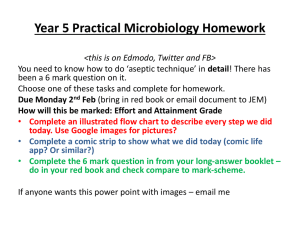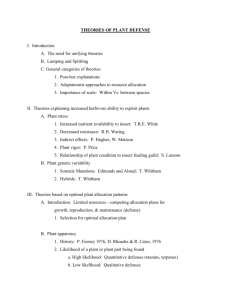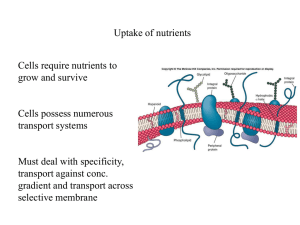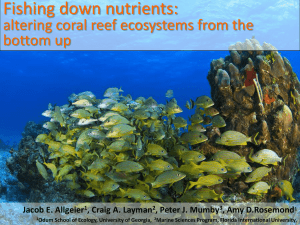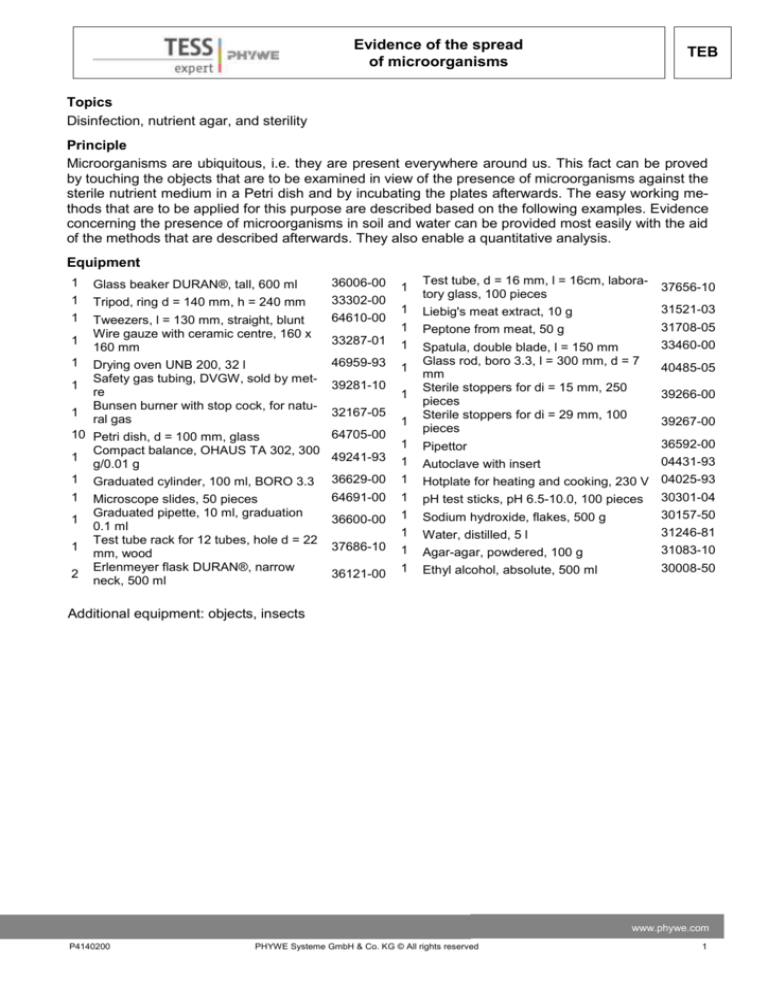
Evidence of the spread
of microorganisms
TEB
Topics
Disinfection, nutrient agar, and sterility
Principle
Microorganisms are ubiquitous, i.e. they are present everywhere around us. This fact can be proved
by touching the objects that are to be examined in view of the presence of microorganisms against the
sterile nutrient medium in a Petri dish and by incubating the plates afterwards. The easy working methods that are to be applied for this purpose are described based on the following examples. Evidence
concerning the presence of microorganisms in soil and water can be provided most easily with the aid
of the methods that are described afterwards. They also enable a quantitative analysis.
Equipment
1
Test tube, d = 16 mm, l = 16cm, laboratory glass, 100 pieces
37656-10
1
Liebig's meat extract, 10 g
31521-03
1
Peptone from meat, 50 g
31708-05
1
Spatula, double blade, l = 150 mm
Glass rod, boro 3.3, l = 300 mm, d = 7
mm
Sterile stoppers for di = 15 mm, 250
pieces
Sterile stoppers for di = 29 mm, 100
pieces
33460-00
1
Pipettor
36592-00
1
Autoclave with insert
04431-93
1
1
Glass beaker DURAN®, tall, 600 ml
36006-00
1
Tripod, ring d = 140 mm, h = 240 mm
33302-00
1
Tweezers, l = 130 mm, straight, blunt
Wire gauze with ceramic centre, 160 x
160 mm
64610-00
33287-01
Drying oven UNB 200, 32 l
Safety gas tubing, DVGW, sold by metre
Bunsen burner with stop cock, for natural gas
46959-93
1
1
1
1
1
39281-10
32167-05
10 Petri dish, d = 100 mm, glass
64705-00
Compact balance, OHAUS TA 302, 300
1
49241-93
g/0.01 g
1 Graduated cylinder, 100 ml, BORO 3.3 36629-00
1
1
1
2
Microscope slides, 50 pieces
Graduated pipette, 10 ml, graduation
0.1 ml
Test tube rack for 12 tubes, hole d = 22
mm, wood
Erlenmeyer flask DURAN®, narrow
neck, 500 ml
1
1
40485-05
39266-00
39267-00
64691-00
1
Hotplate for heating and cooking, 230 V 04025-93
pH test sticks, pH 6.5-10.0, 100 pieces 30301-04
36600-00
1
Sodium hydroxide, flakes, 500 g
30157-50
1
Water, distilled, 5 l
31246-81
1
Agar-agar, powdered, 100 g
31083-10
1
Ethyl alcohol, absolute, 500 ml
30008-50
37686-10
36121-00
Additional equipment: objects, insects
www.phywe.com
P4140200
PHYWE Systeme GmbH & Co. KG © All rights reserved
1
TEB
Evidence of the spread
of microorganisms
Tasks:
1. Provide evidence concerning the presence of microorganisms in the air.
2. Provide evidence concerning the presence of microorganisms on objects of daily use.
3. Provide evidence concerning the presence of microorganisms on the skin.
4. Provide evidence concerning the presence of microorganisms on insects.
Procedure
Evidence of the presence of microorganisms in the air
Evidence of the presence of microorganisms in the air that surrounds us can be provided by exposing
sterile nutrient media in Petri dishes to an infection with microorganisms from the air and by incubating
the plates afterwards. This method is particularly suitable for comparing the concentration of microorganisms in the air in different places, e.g. in the classroom, in a room that is only seldom used, next to a
road with a lot of traffic, in a crowded leisure area, on a calm forest track, etc.
Pour plates with standard nutrient agar for bacteria. After the solidification of the nutrient medium in the
plates, place the open plates for approximately 30 minutes in the places to be examined in order to expose the nutrient agar to microorganisms that fall down from the air. During this time, the covers of the
plates are placed in a slanted manner on the rim of their respective lower parts. Position at least two plates in every place that is to be examined in order to ascertain the results for the comparison of examinations of different places. After the intended time, close the dishes and incubate them at 30°C in an
incubator. For every series of experiments, one additional plate whose nutrient agar had not been exposed to microorganisms in the air must also be incubated in order to verify the sterility of the nutrient medium prior to the start of the experiment.
Evidence of the presence of microorganisms on
objects of daily use
Evidence concerning the presence of the microorganisms on objects of daily use can be provided by touching the sterile nutrient medium in
Petri dishes against the objects and by incubating
the plates afterwards. Interesting objects for examination are, for example, coins, bank notes,
unused towels (especially towels that are to be Fig. 1: The bacteria are transferred by touching the nutrient
used by numerous people), various parts of the
agar against the object.
handset of a telephone, and door handles.
Pour plates with standard nutrient agar for bacteria (see P4140100). After the solidification of the nutrient medium in the dishes, touch its surface slightly
against the object to be examined (Fig. 1). In order to avoid an infection with microorganisms from the air
when opening the dish, hold the cover of the plate so that it covers the lower part of the dish as completely as possible. Ensure that the inside of the plate and the nutrient agar come into contact only with the
object to be examined and not with your fingers. Hold small objects, e.g. coins, with a pair of tweezers,
but you must sterilise the tweezers beforehand.
Close the plates and incubate them at 30°C in the incubator. In order to verify the sterility of the nutrient
medium prior to the experiment, incubate an additional, unused plate with the same nutrient agar for
every series of experiments.
2
PHYWE Systeme GmbH & Co. KG © All rights reserved
P4140200
Evidence of the spread
of microorganisms
TEB
Evidence of the presence of microorganisms on
human skin
Evidence of the presence of microorganisms on
human skin can be provided by touching the sterile
nutrient media in Petri dishes with the tips of one's
fingers and by incubating the plates afterwards. For
comparison, the effectiveness of hygienic measures, e.g. washing one's hands, can also be demonstrated.
bacteria are transferred by touching the nutrient
Pour plates with standard nutrient agar for bacteria Fig. 2: The
agar with your fingers.
(see P4140100). After the solidification of the
nutrient medium in the dishes, touch it slightly with
several fingertips. Lift the cover of the plates only as much as absolutely necessary and hold it so that it
covers the nutrient medium as completely as possible in order to prevent it from being contaminated with
microorganisms from the air (Fig. 2).
Close the plate and incubate it at 30°C in the incubator. In order to verify the sterility of the nutrient medium prior to the experiment, incubate an additional, unused plate with the same nutrient agar.
Evidence of the transfer of microorganisms by insects
Evidence concerning the transfer of microorganisms by insects can be provided by bringing the
sterile nutrient media in Petri dishes into contact
with living insects and by incubating the plates afterwards.
Pour plates with standard nutrient agar for bacteria
(see P4140100). After the solidification of the
nutrient medium, place a living insect, e.g. a
housefly (Musca domestica) or blowfly (Calliphora
erythrocephala) into the closed plate with a pair of
tweezers (Fig. 3). Ensure that any other infection of
the nutrient medium except for by the insect is made impossible. After 5 minutes, let the insect escape by briefly lifting the cover. Then, incubate the
plate at 30°C in the incubator. In order to verify the
sterility of the nutrient medium prior to the experiment, incubate an additional, unused plate.
Results
Fig. 3: A fly on nutrient agar.
Task 1: Evidence of the presence of bacteria in the
air
Within two to three days, colonies of various types of microorganisms develop on the nutrient media that
had been exposed to the air. Their nature, i.e. their size, colour, shape, surface structure, limitation, etc.
can vary to a high extent. Under otherwise identical experiment conditions, the number of colonies depends on the concentration of microorganisms in the air at the sampling location.
Perform a microscopic examination of the colonies as described in P4140300.
The nutrient agar of the control plate that had not been exposed to microorganisms in the air should not
www.phywe.com
P4140200
PHYWE Systeme GmbH & Co. KG © All rights reserved
3
TEB
Evidence of the spread
of microorganisms
show any microbial development.
Task 2: Evidence of the presence of microorganisms on objects of daily use
Within two to three days, colonies of microorganisms develop on the nutrient media that had contact with
an object of daily use. These colonies may differ from each other, but it is also possible that all or nearly
all of them look identical. Their number usually varies
greatly in the case of comparative examinations of
various objects. If the size of the contact surface is
taken into consideration, it can provide an indication
concerning the concentration of microorganisms on
the surface of the examined object.
Perform a microscopic examination of the colonies as
described in P4140300.
The nutrient agar of the unused control plate should
not show any microbial development.
Task 3: Evidence of the presence of microorganisms
on the skin
Within two to three days, bacterial and/or fungal colonies develop on the nutrient media that had been
touched with the fingertips. The number of colonies
depends on the microbial concentration on the skin. If Fig. 4: Evidence of the presence of bacteria in the air.
an experiment is performed before and also after the
test person has washed their hands, the results
should show clear differences.
Perform a microscopic examination of the colonies as described in P4140300.
The nutrient agar of the unused control plate should not show any microbial development.
Task 4: Evidence of the presence of bacteria on insects
Within two to three days, microbial colonies develop on the nutrient medium that had been in contact
with the insect. Perform a microscopic examination of the colonies as described in P4140300.
The nutrient agar of the unused control plate should not show any microbial development.
4
PHYWE Systeme GmbH & Co. KG © All rights reserved
P4140200



